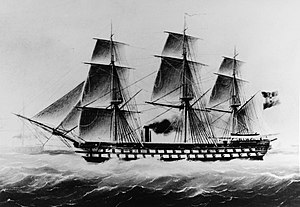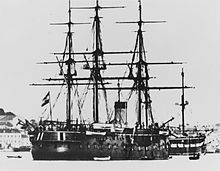SMS Kaiser (1858)
 SMS Kaiser in her original configuration
| |
| History | |
|---|---|
| Name | SMS Kaiser |
| Namesake | Kaiser |
| Builder | Pola Navy Yard |
| Laid down | 25 March 1855 |
| Launched | 4 October 1858 |
| Commissioned | 1859 |
| Renamed | Bellona, 1902 |
| Fate | Unknown after 1918 |
| General characteristics (as built) | |
| Type | Ship of the line |
| Displacement | 5,194 long tons (5,277 t) |
| Length | 74.02 m (242 ft 10 in) |
| Beam | 16.21 m (53 ft 2 in) |
| Installed power |
|
| Propulsion |
|
| Complement | 900 |
| Armament |
|
| Class overview | |
| Name | (As ironclad) |
| Preceded by | Erzherzog Albrecht |
| Succeeded by | Kaiser Max class |
| General characteristics (1873) | |
| Type | Casemate ship |
| Displacement | 5,720 long tons (5,810 t) |
| Length | 78 m (255 ft) |
| Beam | 699 in (58 ft 3 in) |
| Draft | 290 in (24 ft 2 in) |
| Installed power | 2,786 kW ) |
| Speed | 11.55 knots (21.39 km/h; 13.29 mph) |
| Range | 1,519 nautical miles (2,813 km; 1,748 mi) at 10 knots (19 km/h; 12 mph) |
| Complement | 471 |
| Armament |
|
| Armor | |
SMS Kaiser was a 92-gun wooden
In 1869, the Austro-Hungarians decided to rebuild Kaiser into an ironclad
Design
Starting in the early 1850s, the Austrian Empire, faced with a strengthening Kingdom of Sardinia—which unified most of the Italian peninsula in a decade—began to modernize its navy with new steam-driven warships. Archduke Ferdinand Maximilian oversaw the program, which began with the screw frigate Radetzky laid down in Britain in 1852. Two years later, Ferdinand decided a steam ship of the line should be built next; he originally intended the new ship would be built as a copy of the British 91-gun ship of the line HMS Agamemnon, the plans for which the Royal Navy provided to Austria in exchange for the country remaining neutral during the Crimean War of 1853–1856. The excellent performance of the French ship Algésiras during the war prompted the Austrians to modify the Agamemnon design to incorporate features of the French vessel, including a greater size and more powerful machinery. A second vessel of a slightly larger design, to have been named Österreich and armed with 101 guns, was cancelled in 1859 before she was laid down.[1]
The Kaiser was designed by
Service history
The
Battle of Lissa

In June 1866, Italy declared war on Austria, as part of the Third Italian War of Independence, which was fought concurrently with the Austro-Prussian War.[11] Tegetthoff, by now promoted to rear admiral and given command of the entire fleet, brought the Austrian fleet to Ancona on 27 June, in an attempt to draw out the Italians, but the Italian commander, Admiral Carlo Pellion di Persano, refused to engage Tegetthoff.[12] At the time, Kaiser served as the flagship of the 2nd Division of the Austrian fleet, under the command of Anton Petz. On 16 July, Persano took the Italian fleet, with twelve ironclads, out of Ancona, bound for the island of Lissa, where they arrived on the 18th. With them, they brought troop transports carrying 3,000 soldiers.[13] Persano then spent the next two days bombarding the Austrian defenses of the island and unsuccessfully attempting to force a landing. Tegetthoff received a series of telegrams between 17 and 19 July notifying him of the Italian attack, which he initially believed to be a feint to draw the Austrian fleet away from its main bases at Pola and Venice. By the morning of the 19th, however, he was convinced that Lissa was in fact the Italian objective, and so he requested permission to attack.[14]
As Tegetthoff's fleet arrived off Lissa on the morning of 20 July, Persano's fleet was arrayed for another landing attempt. The latter's ships were divided into three groups, with only the first two able to concentrate in time to meet the Austrians. Tegetthoff had arranged his ironclad ships into a wedge-shaped formation, with the wooden warships of the 2nd and 3rd Divisions following behind in the same formation. Kaiser led the 2nd Division at the center of the line. While he was forming up his ships, Persano transferred from his flagship, Re d'Italia, to the turret ship Affondatore. This created a gap in the Italian line, and Tegetthoff seized the opportunity to divide the Italian fleet and create a melee. He made a pass through the gap, but failed to ram any of the Italian ships, forcing him to turn around and make another attempt. In the meantime, Petz took Kaiser and his division further south, hoping to attack the Italian wooden ships that had not joined the action. Instead, the rear of the Italian ironclad line turned to block Petz from Tegetthoff and attacked Kaiser. Petz in turn reoriented his division to attack the Italian ironclads, leading the charge with Kaiser.[15]

The ironclads
By this time, the Austrian ironclads disengaged from the melee to protect their wooden ships; Re d'Italia had been rammed and sunk and the
Conversion and later career

After returning to Pola, Tegetthoff kept his fleet in the northern Adriatic, where it patrolled against a possible Italian attack. The Italian ships never came, and on 12 August, the two countries signed the Armistice of Cormons; this ended the fighting and led to the Treaty of Vienna. Though Austria had defeated Italy at Lissa and on land at the Battle of Custoza, the Austrian army was decisively defeated by Prussia at the Battle of Königgrätz. As a result, Austria, which became Austria-Hungary in the Ausgleich of 1867, was forced to cede the city of Venice to Italy. In the immediate aftermath of the war, the bulk of the Austrian fleet was decommissioned and disarmed.[21]
Chronic budgetary problems confronted the navy of the new Austro-Hungarian Empire; Tegetthoff had great difficulty securing funding for new ships to modernize the fleet. In 1868, he attempted to start a new building program, but the government refused to budget for new warships. Parliament did include funds to modernize Kaiser, however.
The ship was rearmed with a battery of ten 9 in (230 mm) 23-pounder

On 11 February 1874, Kaiser joined the active squadron of the fleet, and became the
The ship did not see further active service. She remained
A commission examined the ship in 1893 and recommended that the ship was "not suitable for commissioning". The government began negotiations with
Notes
- ^ Lambert, pp. 114–115.
- ^ a b Rüstow, p. 670.
- ^ Lambert, p. 147.
- ^ a b c d e f g h Sieche & Bilzer, p. 270.
- ^ Lambert, pp. 114, 147.
- ^ a b c d Pawlik, p. 49.
- ^ Aichelburg, p. 34.
- ^ Greene & Massignani, pp. 210–211.
- ^ Sondhaus, p. 36.
- ^ Sondhaus, p. 1.
- ^ Wilson, pp. 216–218.
- ^ Sondhaus, pp. 1–2.
- ^ Wilson, pp. 221–224, 229–230.
- ^ Wilson, pp. 223–225, 230–236, 238.
- ^ Wilson, pp. 238–240, 244.
- ^ Sondhaus, p. 43.
- ^ Paine, p. 55.
- ^ Wilson, pp. 238–241, 246, 250.
- ^ Sandler, p. 62.
- ^ Sondhaus, pp. 1–3, 8.
- ^ Sondhaus, p. 21.
- ^ a b Scheltema de Heere, p. 19.
- ^ Sondhaus, p. 25.
- ^ Fraccaroli, p. 340.
- ^ Bewegungen, p. 22.
- ^ Sondhaus, p. 100.
- ^ Pawlik, pp. 49–50.
- ^ Pawlik, p. 50.
- ^ Sondhaus, p. 155.
- ^ Pawlik, pp. 50, 59.
- ^ Greger, p. 135.
References
- Aichelburg, Wladimir (1987). Maximilian, Erzherzog von Österreich, Kaiser von Mexiko in zeitgenössischen Photographien [Maximilian, Archduke of Austria, Emperor of Mexico in Contemporary Photographs]. Vienna: Orac. ISBN 978-3-7015-0100-7.
- "Axel Göthrik Adalrik Ljungstedt". Tidskrift i Sjöväsendet (in Swedish) (6/1887). Stockholm: Royal Swedish Society of Naval Sciences. 1887.
- "Bewegungen S. M. Kriegsschiffe vom 1. September 1873 bis 31. August 1874" [Movements of S. M. Warships from 1 September 1873 to 31 August 1874]. Jahrbuch der Kais. Kön. Kriegsmarine [Yearbook of the Imperial and Royal Navy]. Pola: Verlag der Redaction: 15–26. 1874.
- Fraccaroli, Aldo (1979). "Italy". In Gardiner, Robert (ed.). Conway's All the World's Fighting Ships 1860–1905. London: Conway Maritime Press. pp. 334–359. ISBN 978-0-85177-133-5.
- Greene, Jack & Massignani, Alessandro (1998). Ironclads at War: The Origin and Development of the Armored Warship, 1854–1891. Pennsylvania: Da Capo Press. ISBN 978-0-938289-58-6.
- Greger, René (1976). Austro-Hungarian Warships of World War I. London: Ian Allan. ISBN 978-0-7110-0623-2.
- Lambert, Andrew (1984). Battleships in Transition. The Creation of the Steam Battlefleet 1815–1860. London: Conway Maritime Press. ISBN 978-0-85177-315-5.
- Paine, Lincoln (2000). Warships of the World to 1900. Boston: Houghton Mifflin Harcourt. ISBN 978-0-395-98414-7.
- Pawlik, Georg (2003). Des Kaisers Schwimmende Festungen: die Kasemattschiffe Österreich-Ungarns [The Kaiser's Floating Fortresses: The Casemate Ships of Austria-Hungary]. Vienna: Neuer Wissenschaftlicher Verlag. ISBN 978-3-7083-0045-0.
- OCLC 20029853.
- Scheltema de Heere, R. F. (1973). Fisher, Edward C. (ed.). "Austro-Hungarian Battleships". Warship International. X (1). Toledo: Naval Records Club, Inc.: 11–97. ISSN 0043-0374.
- Sieche, Erwin & Bilzer, Ferdinand (1979). "Austria-Hungary". In Gardiner, Robert; Chesneau, Roger & Kolesnik, Eugene M. (eds.). Conway's All the World's Fighting Ships 1860–1905. London: Conway Maritime Press. pp. 266–283. ISBN 978-0-85177-133-5.
- Sondhaus, Lawrence (1994). The Naval Policy of Austria-Hungary, 1867–1918. West Lafayette: Purdue University Press. ISBN 978-1-55753-034-9.
- Sandler, Stanley (2004). Battleships: An Illustrated History of Their Impact. Santa Barbara: ABC-CLIO. ISBN 978-1-85109-410-3.
- OCLC 1111061.
Further reading
- Ortner, Christian. "Der Seekrieg in der Adria 1866". Viribus Unitis: Jahresbericht 2010 des Heeresgeschichtlichen Museums. Vienna: Heeresgeschichtliches Museum: 100–124. OCLC 499702006.
